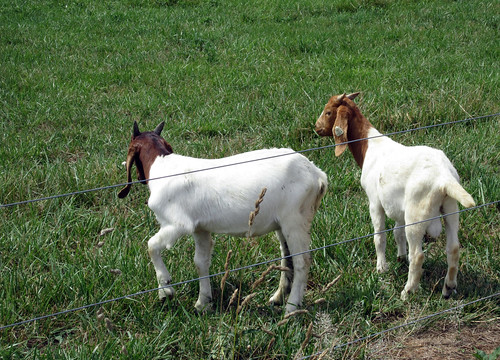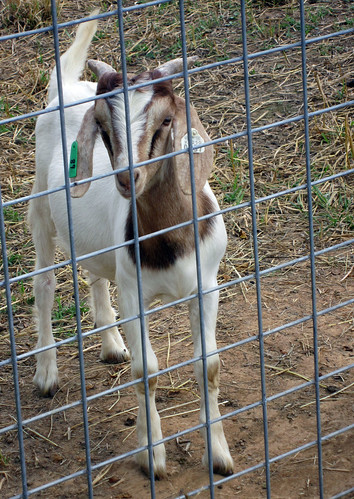For the second weigh period, the goats posted modest gains, an average of 2.1 lbs. Among individual goats, the two-week gain ranged from -3 to 7 lbs. Only seven goats lost weight since June 23. Looking at it another way, average daily gain (ADG) ranged from -0.21 to 0.50 lbs. per day and averaged 0.15 lbs. (68 g) per day.
For the period, the top-gaining goat was a Kiko buck consigned by P.J. Murphy (New Jersey). Four bucks gained 0.36 lbs. per day for the period. The consignors of these top-performing bucks are Randy Allen (Tennessee), Merritt Burke (Delaware), Kentucky State University, and Hannah Zitta (Virginia).
Day 28
For the first 28 days of the test, ADG ranged from -0.19 to 0.37 lbs. per day and averaged 0.103 lbs. (47 g) per day. Nine goats have failed to gain weight since June 10.
So far, the top-gaining buck is a Savanna buck consigned by Janet & Stephen Garrett (Virginia). The top consignor is Lucas Miller (Indiana). His three Boer x Kiko bucks have gained an average of 0.22 lbs. (100 g) per day. The second best consignment is from Merritt Burke. Burke's five Kiko bucks have gained an average of 0.20 lbs (91 g) per day since June 10.
Other scores
On July 7, FAMACHA© scores ranged from 1 to 3 and averaged 1.62, compared to 1.74 on June 23. Only two goats required anthelmintic treatment. While their FAMACHA© scores were only 3, other factors led to the decision to deworm. A few other goats with FAMACHA© scores of 3 were not dewormed, because they had good Five Point Check© scores.
Dag scores continued to improve. Fecal tags were dry and the goats' feces were pelleted. Only one goat showed any signs of scouring and had a positive dag score. Average body condition and coat conditions scores improved slightly. Only one goat had a body condition and coat condition score below 2.0.
June 23 fecals
For the fecal samples collected on June 23, fecal egg counts (FECs) ranged from 0 to 1,675 epg and averaged 138 epg. No goat had what would be considered a very high egg count. While 1,675 epg may seem like a high count, barber pole worms lay a lot of eggs. In fact, 2,000 epg is considered clinically significant for the barber pole worm. At the same time, you'd prefer to have a buck that is shedding the least amount of eggs onto the pasture.
Tapeworm eggs and coccidia oocytes were observed in some of the individual fecal samples. The tapeworm eggs are not of concern and the presence of coccidia oocytes in the fecal samples is not unexpected; nor can it be interpreted, as not all coccidia are pathogenic or equally pathogenic.
In addition to individual fecal samples, a pooled fecal sample was collected from random goats. This sample was sent to the University of Georgia for larvae identification. Pooled samples will be collected every 4 weeks during the test period. It takes several weeks to get the results of the testing.
Fecal egg count reduction
The double deworming (of moxidectin + levamisole) given to all the goats on June 10 was determined to be 80 percent effective. On June 10, sixty-one goats with non-zero egg counts had an average fecal egg count of 918 epg. On June 23, the average egg count had been reduced by 80 percent to 181 epg.
The effectiveness of the anthelmintic treatment varied by consignor and individual goats. In some cases, fecal egg counts went up after the anthelmintic treatment. Consignors should look at the data from their bucks to determine the level of anthelmintic resistance that may be present in their herds.
For an anthelmintic treatment to be considered effective, it should reduce egg counts by 90 percent or more (preferably 95 percent). No anthelmintic treatment will be 100 percent effective, which is why drug resistance is inevitable and a growing problem.
Fresh pasture
After being worked, the goats were given access to a fresh 2-acre paddock of pearl millet. This is both a clean pasture and a lush pasture. The goats will be allowed to removed half of the forage before being rotated to another paddock. This nutritious pasture should allow the goats to continue to gain weight. At the same time, overall pasture conditions have deteriorated due to the scarcity of rainfall. Hopefully, this situation will not continue and worsen.
Penned goats
The goats in the pen had similar data as the bucks in the pasture test. On average, the pastured goats have gained better, but this is probably because the penned goats gained more weight during the adjustment period.
In a pen feeding situation, dominant goats can also be more of a problem. Goats that are too submissive will not get their fair share of grain. Dominance is a bigger factor in a confined feeding system.
The goats were worked today by Jeff Semler, David Gordon, Mary Beth Bennett, Jeanne Dietz-Band, and Susan Schoenian. Data were recorded by Pam Thomas. The next work day is July 21.
Download July 7 report
For the period, the top-gaining goat was a Kiko buck consigned by P.J. Murphy (New Jersey). Four bucks gained 0.36 lbs. per day for the period. The consignors of these top-performing bucks are Randy Allen (Tennessee), Merritt Burke (Delaware), Kentucky State University, and Hannah Zitta (Virginia).
 |
| P.J. Murphy's top-gaining Kiko buck (cell phone image by Jeff Semler) |
Day 28
For the first 28 days of the test, ADG ranged from -0.19 to 0.37 lbs. per day and averaged 0.103 lbs. (47 g) per day. Nine goats have failed to gain weight since June 10.
So far, the top-gaining buck is a Savanna buck consigned by Janet & Stephen Garrett (Virginia). The top consignor is Lucas Miller (Indiana). His three Boer x Kiko bucks have gained an average of 0.22 lbs. (100 g) per day. The second best consignment is from Merritt Burke. Burke's five Kiko bucks have gained an average of 0.20 lbs (91 g) per day since June 10.
Other scores
On July 7, FAMACHA© scores ranged from 1 to 3 and averaged 1.62, compared to 1.74 on June 23. Only two goats required anthelmintic treatment. While their FAMACHA© scores were only 3, other factors led to the decision to deworm. A few other goats with FAMACHA© scores of 3 were not dewormed, because they had good Five Point Check© scores.
Dag scores continued to improve. Fecal tags were dry and the goats' feces were pelleted. Only one goat showed any signs of scouring and had a positive dag score. Average body condition and coat conditions scores improved slightly. Only one goat had a body condition and coat condition score below 2.0.
 |
| Couple of Boer bucks |
June 23 fecals
For the fecal samples collected on June 23, fecal egg counts (FECs) ranged from 0 to 1,675 epg and averaged 138 epg. No goat had what would be considered a very high egg count. While 1,675 epg may seem like a high count, barber pole worms lay a lot of eggs. In fact, 2,000 epg is considered clinically significant for the barber pole worm. At the same time, you'd prefer to have a buck that is shedding the least amount of eggs onto the pasture.
Tapeworm eggs and coccidia oocytes were observed in some of the individual fecal samples. The tapeworm eggs are not of concern and the presence of coccidia oocytes in the fecal samples is not unexpected; nor can it be interpreted, as not all coccidia are pathogenic or equally pathogenic.
In addition to individual fecal samples, a pooled fecal sample was collected from random goats. This sample was sent to the University of Georgia for larvae identification. Pooled samples will be collected every 4 weeks during the test period. It takes several weeks to get the results of the testing.
 |
| Boer x Kiko buck from Maryland |
Fecal egg count reduction
The double deworming (of moxidectin + levamisole) given to all the goats on June 10 was determined to be 80 percent effective. On June 10, sixty-one goats with non-zero egg counts had an average fecal egg count of 918 epg. On June 23, the average egg count had been reduced by 80 percent to 181 epg.
The effectiveness of the anthelmintic treatment varied by consignor and individual goats. In some cases, fecal egg counts went up after the anthelmintic treatment. Consignors should look at the data from their bucks to determine the level of anthelmintic resistance that may be present in their herds.
For an anthelmintic treatment to be considered effective, it should reduce egg counts by 90 percent or more (preferably 95 percent). No anthelmintic treatment will be 100 percent effective, which is why drug resistance is inevitable and a growing problem.
Fresh pasture
After being worked, the goats were given access to a fresh 2-acre paddock of pearl millet. This is both a clean pasture and a lush pasture. The goats will be allowed to removed half of the forage before being rotated to another paddock. This nutritious pasture should allow the goats to continue to gain weight. At the same time, overall pasture conditions have deteriorated due to the scarcity of rainfall. Hopefully, this situation will not continue and worsen.
 | |
| Penned goat (from Kentucky) |
Penned goats
The goats in the pen had similar data as the bucks in the pasture test. On average, the pastured goats have gained better, but this is probably because the penned goats gained more weight during the adjustment period.
In a pen feeding situation, dominant goats can also be more of a problem. Goats that are too submissive will not get their fair share of grain. Dominance is a bigger factor in a confined feeding system.
The goats were worked today by Jeff Semler, David Gordon, Mary Beth Bennett, Jeanne Dietz-Band, and Susan Schoenian. Data were recorded by Pam Thomas. The next work day is July 21.
Download July 7 report











